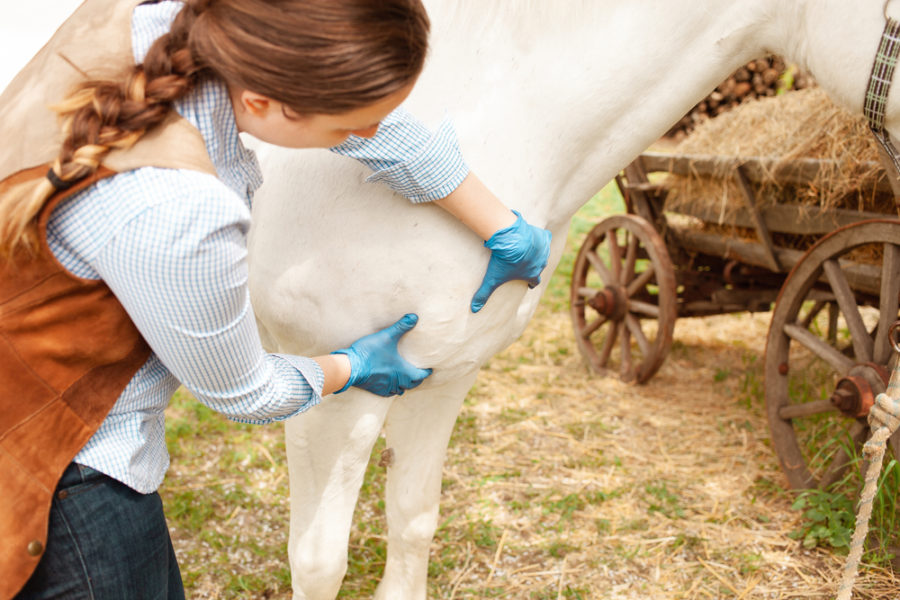Could your horse benefit from some additional strength training? Here are a few easy ways to build up his weak muscle zones.
Let’s be honest – some horses can be a little lazy. They want to rest in the paddock, relax and eat their way through the day, and it’s hard to blame them! Even the most active horses don’t have goals (like we do) to reach peak physical condition, so building his weak muscle zones has to be a combined effort between the two of you! Fortunately, there are a variety of exercises that can make this easier.
Try hill work
One of the best ways to improve and build muscle in your horse is to engage him in an activity that’s above his normal level of exertion. According to Dr. Nancy Mauer of Spruce Run Equine Vet Associates, hills are one of the best tools when increasing muscle mass, especially in the chest and hind quarters. “Going up hills is one of the best things you can do to build muscle,” Dr. Mauer states. “It allows for the horse to exert himself just enough, especially if the pace is well controlled and the time is appropriate. However, going down the hill, he needs to be sure not to travel too quickly. Depending on the horse and his own history of prior injury, it is important to make sure he travels at a speed that enables him to find and keep his footing at all times. Inducing a fall with an improper hill descent is extremely undesirable.”
Use cavaletti poles
Another way to improve muscle mass is to take him over cavaletti poles. They can be placed in a line so that he has to be aware of his leg motions and be sure to lift his hooves each time to clear. According to Dr. Daniel Halden, an equine chiropractor based in Pennsylvania, spacing the poles the same distance as the horse is tall at his withers is best. This ensures that he continues to walk over the poles correctly based on his size. “Cavaletti work specifically targets foot awareness,” says Dr. Halden. “The correct use and placement of all four feet and legs in proper coordination is a critical underpinning to building strength, muscle mass and endurance.” These poles can be arranged in a variety of different ways to engage different muscles. For instance, try setting up a maze for him to travel through, winding and weaving in order to get to the end. This type of cavaletti pattern requires him to bend and utilize muscles he may not typically need in his daily life.
Explore different terrain
Different terrain options are also helpful for building muscle zones. It is very different for a horse to walk on grass versus arena sand. On grass, he must navigate uneven footing and utilize muscles to stabilize himself. According to Dr. Halden, it’s useful to work the horse when the grass is both wet and dry as these are very different experiences. While on arena sand, he slightly sinks, thus each step he takes requires more effort. By taking him over a variety of safe, horse-friendly surfaces, he has to think about his motions and try harder to propel himself forward. Whenever possible, avoid rocks and concrete as these are hard on the hooves and joints.
Ride him right
Correct rider and horse contact is important for muscle usage as well. “The horse benefits from ‘engaging’ or pushing off the hindquarters,” says Dr. Mauer. “You will hear a horse described as engaged, light in front, balanced, ready to go in any direction. When mounted, one can contain and direct their mount’s energy by applying their leg cues while an elastic contact on the mouth keeps the propulsion balanced. This also develops the ‘core’ muscles, conditioning the whole animal for stamina and comfort.” It is evident then that a horse needs proper rider direction in order to utilize his vast muscle reservoir. “Conversely, a horse might be described as ‘heavy on the forehand’ or ‘flat’,” continues Dr. Mauer. “The second scenario does not paint a picture of grace or preparedness, and changes in direction or speed appear less fluid.” She adds that it is paramount that the rider allows for days of rest to avoid overworking the horse.
Encourage regular movement
Lastly, and probably most obviously, the horse was built to move. He was designed to run and cover great distances. While most of us do not encourage the horse to spend a great deal of time in motion, an appropriate amount of exercise above the level of a walk is going to be the most effective at building muscle. The horse needs to trot, canter, and if the rider is experienced and able, gallop. Allowing the horse to move at whatever level the rider is comfortable is always going to help him get stronger.
There is a reason the world ran on the hooves of a horse for centuries! By incorporating some of the above ideas, you can increase your horse’s muscle mass and improve his ability to perform with strength and ease.



